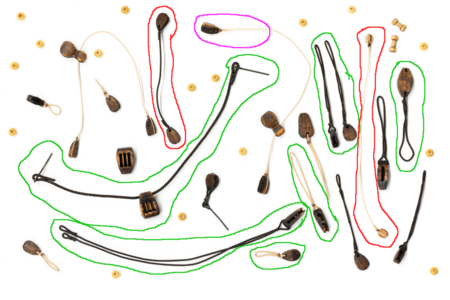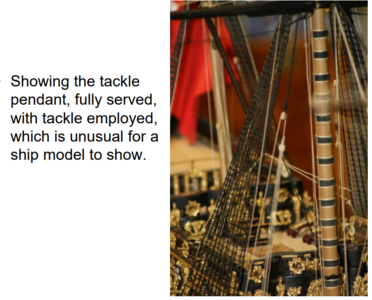I've used the appropriate spreadsheet to determine the proper size of various standing and running rigging on my model, and from that determined the proper size blocks. But I see nothing said concerning the size of the rope used for the block's pendant rope. (I hope I am using the proper terminology.) To illustrate my question, I will post a marked up version of Olha's Carrack rigging, since that is what I'm building:

3 conditions exist:
The pendants outlined in GREEN have two ropes supporting each block, and assuming these are all single blocks, the support an object also supported by 2 ropes. In other words, the pulling force for each rope supporting the block is the same as the pulling force for each rope going through the block. Since the force is the same, I would expect all ropes to be the same size.
The pendants outlined in RED have only a single rope supporting each block. The total force on that rope will be the total force by the 2 ropes going through the block, or twice the force of a single rope. Therefore, I would expect those pendant ropes in red to be larger in size. Going by rope area alone, the larger pendant rope would be 1.41 times the size of the pulley rope, although I have read that larger ropes are proportionally weaker, so 1.5 times the pully rope size seems appropriate. Does that sound correct?
The block and pendant portion outlined in PURPLE supports a single block, which would have 2 ropes going through its pulley, so I would think that this rope would again be about 1.5 times the rope size going through the pulley. The Central block is supported by 2 ropes, so the rope size of its pulley would be the same as the pendant size.
Anyhow, that makes sense to me, but the big question is: Is there a rule or chart to indicate the proper size of single pendants on blocks? What do you do? Does my assumption of 1.5 times the pulley rope size make sense to you?
Oh, and a secondary question I just thought of: Are all such pendants considering Standing rigging, as in most cases the pendant ropes do not go through blocks, and therefore should be black/brown rather than tan? Most, but not all, of Olha's examples are black.

3 conditions exist:
The pendants outlined in GREEN have two ropes supporting each block, and assuming these are all single blocks, the support an object also supported by 2 ropes. In other words, the pulling force for each rope supporting the block is the same as the pulling force for each rope going through the block. Since the force is the same, I would expect all ropes to be the same size.
The pendants outlined in RED have only a single rope supporting each block. The total force on that rope will be the total force by the 2 ropes going through the block, or twice the force of a single rope. Therefore, I would expect those pendant ropes in red to be larger in size. Going by rope area alone, the larger pendant rope would be 1.41 times the size of the pulley rope, although I have read that larger ropes are proportionally weaker, so 1.5 times the pully rope size seems appropriate. Does that sound correct?
The block and pendant portion outlined in PURPLE supports a single block, which would have 2 ropes going through its pulley, so I would think that this rope would again be about 1.5 times the rope size going through the pulley. The Central block is supported by 2 ropes, so the rope size of its pulley would be the same as the pendant size.
Anyhow, that makes sense to me, but the big question is: Is there a rule or chart to indicate the proper size of single pendants on blocks? What do you do? Does my assumption of 1.5 times the pulley rope size make sense to you?
Oh, and a secondary question I just thought of: Are all such pendants considering Standing rigging, as in most cases the pendant ropes do not go through blocks, and therefore should be black/brown rather than tan? Most, but not all, of Olha's examples are black.







